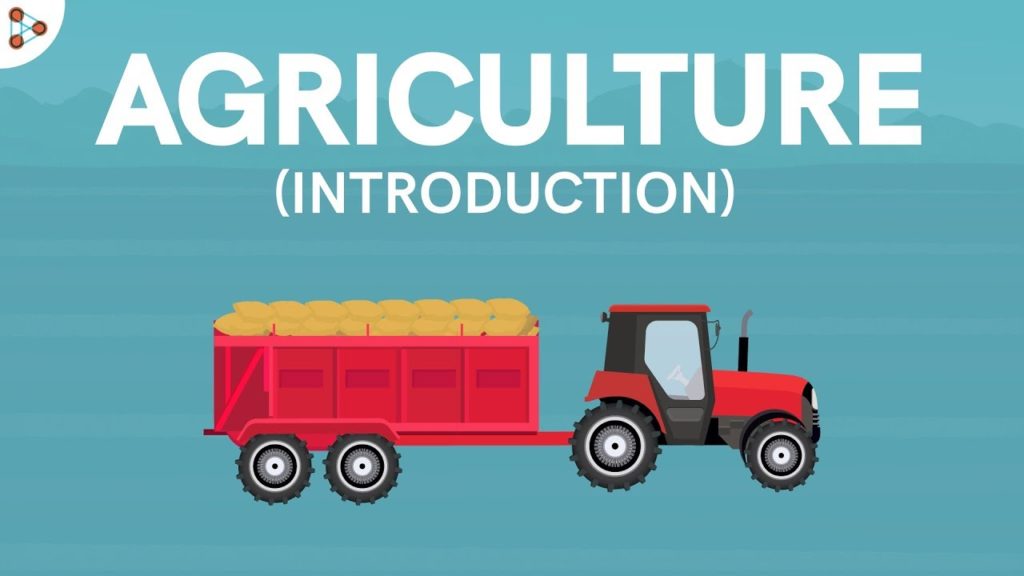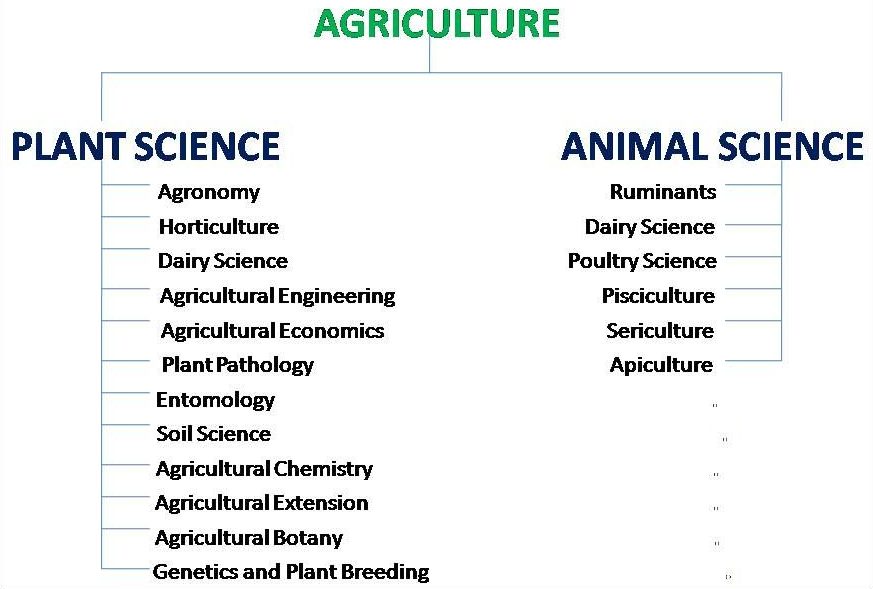Back to: AGRICULTURAL SCIENCE SS1
Welcome to class!
In today’s class, we will be talking about the introduction to agriculture. Enjoy the class!
Introduction to Agriculture: Meaning, Branches and Importance of Agriculture

- Meaning of Agriculture
- Branches of Agriculture
- Importance of Agriculture
Meaning of agriculture
Agriculture is the art and science (or management) that deals with the cultivation of crops and the rearing of animals for man’s use. This means it refers to all the activities involving the cultivation of the soil for the production of crops and livestock management to the distribution and marketing of the plant and animal products.
The term, agriculture, is derived from two Latin words which are:
- “Ager” which means field/farm/land.
- “Culture” which means cultivation.
By this, agriculture means field cultivation. However, this is not a complete definition of agriculture since agriculture also has to do with animal production.
Self-evaluation:
- Define Agriculture.
- State the two Latin words from which the term Agriculture is derived from and their meanings.
Branches of agriculture

The branches of Agriculture include the following:
- Animal Science/Animal Husbandry/Animal Production: Animal Science ensures the efficient and effective management of farm animals. It ensures better animal productivity.
- Veterinary Medicine/Animal Health: Veterinary medicine provides better health management for farm animals. It ensures the control of pests, parasites and diseases of farm animals.
- Soil Science: Soil science ensures the maintenance of soil fertility, better soil classification and mapping. It also helps in erosion control, soil moisture conservation and application of appropriate fertilizer for different soil types.
- Crop Production/Crop Science: Crop production helps in effective crop management practices, development of better planting materials, correct crop spacing, etc. The aspects of crop production include Agronomy, Crop Pathology and Entomology.
- Agricultural Economics and Farm Management: It ensures the effective management of agricultural resources, promotes agricultural marketing and good farm accounting.
- Agricultural Engineering: It promotes the mechanization of farm operations, development of processing and storage equipment and also maintenance of farm tools and equipment.
- Forestry and Wildlife Conservation: It promotes the conservation of forest products, wildlife and also the creation of microclimate.
- Agricultural Extension and Education: It promotes the training and dissemination of agricultural information to farmers, and also link farmers to researchers.
- Fishery: It promotes the production of fish, its management, processing and other fishing Practices.
- Apiculture/Bee Farming: It promotes the production of honey for local consumption/uses.
- Heliculture/Snailry: It involves the production of snails for consumption as a source of protein and minerals.
Self-evaluation:
- Define these aspects of crop science:
(a) Agronomy (b) Crop Pathology (c) Entomology
- State three functions of (a) Veterinary Medicine (b) Agricultural Extension
- What are agro-based industries?
Importance of agriculture

- Provision of food: Agriculture provides food such as maize, rice, yam, vegetables, fruits, meat, and milk, either in fresh form or processed form for man and farm animals.
- Source of materials for clothing: Agriculture provides fibre and cotton for textile production. It also provides hides and skin for clothing, shoes, belts, caps, and bags.
- Provision of materials for shelter and furniture: Agriculture provides timber for making building materials such as doors, windows, roofs, poles etc. Timber is also used for making furniture such as shelves, cabinets, tables, chairs etc.
- Provision of income: Agriculture generates income for farmers and farm labour through sales of plants and animal products and wages or salaries.
- Source of employment: Agriculture and other agro-based industries employ farmers, farmworkers and other people who engage in agricultural finance and marketing.
- Provision of raw materials for industries: Agriculture provides raw materials for agro-based industries (industries which depend on agriculture for their raw materials). It provides cotton and wool for textile industries, cocoa, coffee, tea and kola nut for beverage industries, rubber latex for tyres and foams industries etc.
- Sources of foreign exchange: Agriculture contributes significantly to foreign exchange earning in Nigeria through the export of cocoa, coffee, groundnut, cotton, palm produce, timber e. t. c. to other countries.
- Provision of a market for industrial goods: Finished products from agro-allied industries such as fertilizers, pesticides, herbicides, agro-pharmaceutical drugs, farm tools, machines as well as storage and processing facilities are used in the agricultural sector.
- Development of rural areas: Agriculture brings about development in rural areas as social amenities such as good roads, electricity, pipe-borne water, schools and hospitals are provided where commercial agriculture exists.
- Provision of facilities for recreation and tourism: Agriculture leads to the establishment of game reserves. It also provides horse for horse racing and polo.
Self-evaluation:
- Outline five importance of agriculture.
- Give five examples of agro-based industries
- State five agricultural raw materials and the industries that use them.
General evaluation
- What is Agriculture?
- List and define eight branches of Agriculture.
- State ten relevance of agriculture.
- What are agro-allied industries? State five examples of them.
- State five Agricultural raw materials and the industries that use them.
- Define these aspects of crop science:
(a) Agronomy (b) Crop Pathology (c) Entomology
Reading assignment
Essential Agricultural Science by O. A. Iwena, Chapter 1; pages 2-6.
Fundamental Agricultural Science P. E. Okafor. Chapter 1; pages 1- 4
THEORY
- (a) Define Agriculture
(b) State ten importance of agriculture
- List and define ten branches of agriculture.
In our next class, we will be talking about the Types of Agriculture: Subsistence and Commercial Agriculture. We hope you enjoyed the class.
Should you have any further question, feel free to ask in the comment section below and trust us to respond as soon as possible.

[email protected]
Amarachi, this great, keep it up
I have really enjoyed the class stay focused
This class is very intresting or what do u think
I love your comment
Glad you found it helpful😊 For even more class notes, engaging videos, and homework assistance, just download our Mobile App at https://play.google.com/store/apps/details?id=com.afrilearn. It’s packed with resources to help you succeed🌟
This is great thank you very much
Thank you so much I really love this
I love you comment opeyemi it so grateful
Glad you found it helpful😊 For even more class notes, engaging videos, and homework assistance, just download our Mobile App at https://play.google.com/store/apps/details?id=com.afrilearn. It’s packed with resources to help you succeed🌟
wow so helpful
Thank you very much
I’m kindly asking for all the agriculture summaries
I really enjoyed the class
thanks
Very helpful..thanks and God bless you
Wonderful thanks
Agriculture concerns with the cultivation of crop rearing animals for the benefit of man, agriculture provide job opportunity and rendering exchange
I really appreciate Benue state for the inprovement of production of Agricultural cultivation in order forward the Economy in our country
List out five different places agriculture can serves as source of employment to the society
Ya this is very helpful thanks so much
This is good and great.Ilt is leaving made easier and affordable.
Nice One
thanks so much this is really good
Thank you for your support to my Education making it easy for me, God bless you Amen 🙏
Thing so amazing and good
This note is interesting. 😘
Thanks for this🥰
God bless you, you are doing a great job, so helpful
We’re glad you found it helpful😊 For even more class notes, engaging videos, and homework assistance, just download our Mobile App at https://play.google.com/store/apps/details?id=com.afrilearn. It’s packed with resources to help you succeed🌟
I really enjoyed the class
thanks
really?
Hi
i enjoyed it
wow interesting I enjoyed it
wonderful 😊 thank you so much
THANKS